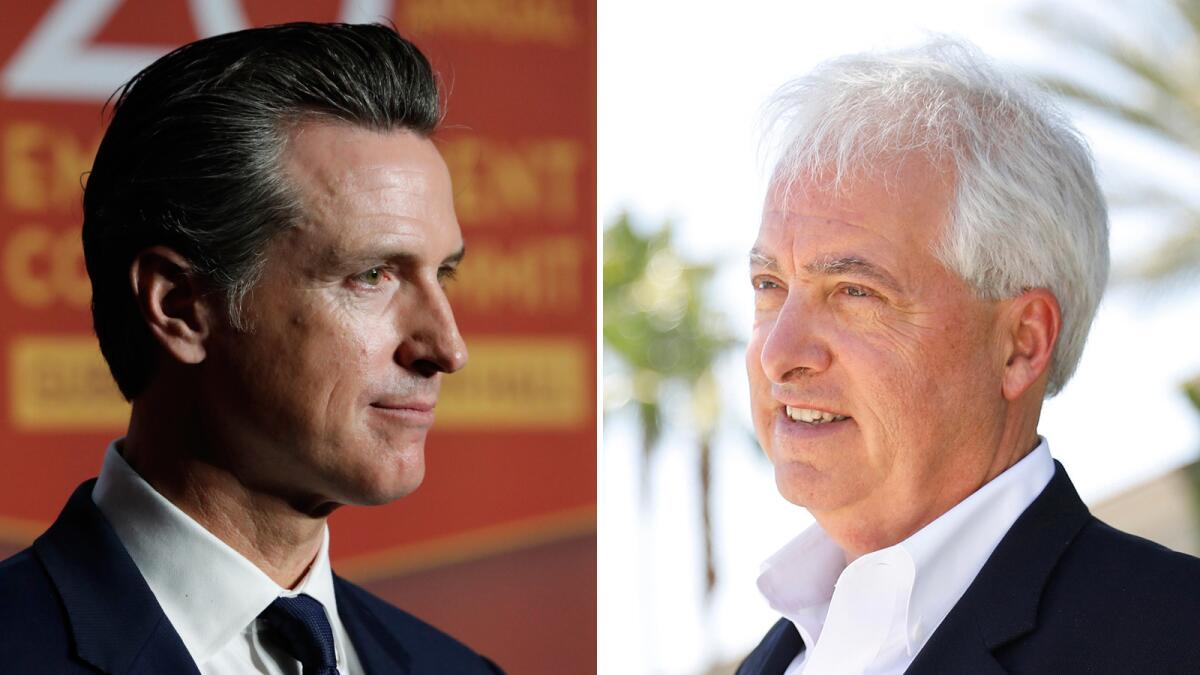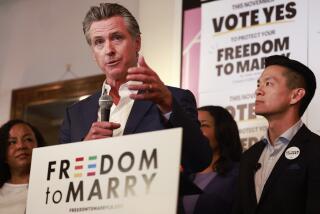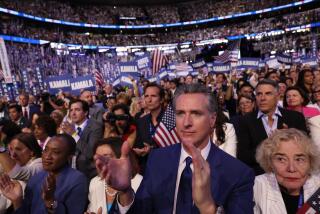Poll finds Newsom has a commanding lead over Cox in California governor’s race

Democrat Gavin Newsom has a dominant lead over Republican John Cox in California’s race for governor, a contest in which a significant number of voters appear to have cast ballots strategically to sway the outcome of the state’s top-two primary, according to a new USC Dornsife/Los Angeles Times poll.
Forty-five percent of registered voters who said they planned to vote in the November race intend to support Newsom, while Cox won the support of 28% of those who plan to cast ballots, according to the poll. Twenty-seven percent of those voters were undecided.
The post-primary survey also indicated that some Californians are adapting their behavior in response to the state’s relatively new top-two primary, where the pair of candidates who get the most votes move on to the general election regardless of party.
Three out of 10 Californians who voted for Cox said they did so primarily because they wanted to ensure a Republican was on the November ballot, as opposed to supporting him because he reflected their beliefs and values, or some other reason, the survey found.
“Voters are learning how to strategically game the system,” said Bob Shrum, director of the Jesse M. Unruh Institute of Politics at USC. “I think we’re going to see more of this in California.”
Two-thirds of voters polled said they cast ballots in the June 5 primary for the candidate who best reflected their beliefs, or who they believed would be the best to lead the state. But 1 in 5 voters said they decided whom to support with the goal of making sure someone from their party advanced to the November general election or for a Democrat-on-Democrat contest.
The GOP faced the prospect of a November ballot without a Republican contender because of the stronger Democratic field of candidates and the Democrats’ significant edge in voter registration in the state. In the months running up to the election, Cox and Democrat Antonio Villaraigosa jockeyed for second place in public polling.
For Villaraigosa, roughly equal numbers of voters in the poll said they chose him to ensure that two Democrats advanced to the general election as did those who said their decision was based on his values. He ultimately finished third, and received only 13% of the vote to Cox’s 26% and Newsom’s 34%.
Meet John Cox and Gavin Newsom, the candidates for California governor >>
GOP strategist Mike Murphy, an analyst for the poll, doubted voters cast ballots strategically in the race. There was no evidence that Republicans crossed party lines to back Villaraigosa, who was a more moderate choice than Newsom and had a better chance of victory in November than Cox, he said. If they had, that would have been a true example of strategic voting, he added.
The USC/LAT poll of 893 Californians was in the field immediately following the primary. Conducted online in English and Spanish from June 6 to Sunday, the poll’s margin of error is 4 percentage points in either direction, and larger for subcategories of voters based on registration, voting behavior, age, ethnicity, party affiliation and other demographic indicators.
The polling shows Newsom won nearly every subgroup the Democrats competed for — liberal and moderate Democrats, across age groups, education attainment levels and in each area of the state. The sole exception was Latinos — Villaraigosa received nearly double the support Newsom did in the survey.
According to the survey, the problem for Villaraigosa was that Latinos, along with other voters he was relying upon, including those in Los Angeles County, failed to turn out in the numbers he needed to boost his bid.
About 14% of Latinos voted, compared to 41% of whites, the poll shows. According to election returns, about 23% of voters in Villaraigosa’s home turf of Los Angeles cast ballots, while 39% did in the Bay Area, Newsom’s base of support due to his time as mayor of San Francisco. About 23% of voters who did not have a college degree turned out, the poll shows, while 37% of those with degrees cast ballots.
Villaraigosa reflects after a bruising loss in California governor’s race >>
“I just don’t think [Villaraigosa] ever got off the ground,” Murphy said. “He just didn’t do what he had to do. He did better among Hispanics than he did anywhere else, but he didn’t do well enough…. The Villaraigosa campaign fell flat.”
Meanwhile, Cox was able to consolidate support among GOP voters, allowing him not only to beat Republican rival Travis Allen by a wide margin, but to surge past Villaraigosa to claim the second spot in the primary.
Any hope Villaraigosa had of competing for moderate Republican votes because of his positions on healthcare and education were dashed, according to the poll. He received strong support from charter school advocates, who poured $23 million into an effort backing him — the largest independent expenditure effort in a gubernatorial primary in California history. The former Los Angeles mayor also expressed some concerns over launching a California single-payer healthcare program supported by Newsom, calling it unaffordable.
Shrum pointed to President Trump’s endorsement of Cox as a game-changer. The nod was seen as an attempt to elevate Cox among California conservatives so he would have enough Republican support to finish in the top two and land on the November ballot, in turn helping to boost GOP turnout and Republican candidates in tight congressional races.
“The Trump embrace told Republicans, ‘You need to vote for him,’” Shrum said.
But Cox’s ties to Trump and his policies stand to harm him with the voters he needs to court in the general election, Murphy said. Democratic presidential nominee Hillary Clinton trounced Trump in California in the 2016 election, beating him by more than 4 million votes.
The potential political downside of Cox’s affiliation with Trump surfaced on Monday. While in Sacramento to campaign for a ballot proposition to repeal the state’s increased gas tax, Cox was peppered with questions from reporters about the Trump administration’s policy of separating immigrant parents from their children at the U.S.-Mexico border. Cox called it “horrendous,” but he called on Congress to fix the policy and refrained from directly criticizing Trump.
It’s Newsom vs. Cox in November as Villaraigosa tumbles in governor’s race >>
Along with touting Trump’s endorsement, Cox’s opposition to the so-called ”sanctuary state” policy, which limits state and local law enforcement cooperation with federal immigration agents, will probably help consolidate his support among conservatives in November. But his positions are likely to repel Democrats and many independent voters, and Cox needs to expand his support far beyond the GOP to succeed in November.
“There’s really no path for Cox to get out of the primary box he’s painted himself in,” Murphy said. “He is in a state where there is very little oxygen for a Republican to breathe.”
Cox is pinning his campaign on the Republican-led effort to repeal the 2017 increase in gas taxes and vehicle fees. Among Californians who supported repeal, Cox had a nine-percentage-point lead over Newsom, according to data from polls conducted before and after the primary.
The tax is unpopular, but Shrum said Cox could be overestimating how many voters he’ll win over by tying himself to the repeal effort.
Californians opposed to the new levies might not agree with Cox on other big issues, including immigration and healthcare, Shrum said.
“You can repeal the gas tax without voting for Cox for governor,” he said.
The poll shows the most important issues to Democrats include healthcare, education and affordable housing, all of which the Newsom campaign has said the candidate will address in office. Along with being an early advocate for a state-sponsored single-payer healthcare system in California, Newsom is advocating for an expansion of early childhood education and lowering college tuition.
Fiscal issues including taxes and state spending were the most crucial to Republicans, according to the survey, along with illegal immigration.
“There are two different worlds here,” Murphy said.
Jill Darling, survey director of the USC Dornsife Center for Economic and Social Research, contributed to this report.
Meet John Cox and Gavin Newsom, the candidates for California governor »
Coverage of California politics »
[email protected]; [email protected]
Twitter: @LATSeema, @philwillon
More to Read
Get the L.A. Times Politics newsletter
Deeply reported insights into legislation, politics and policy from Sacramento, Washington and beyond. In your inbox three times per week.
You may occasionally receive promotional content from the Los Angeles Times.












